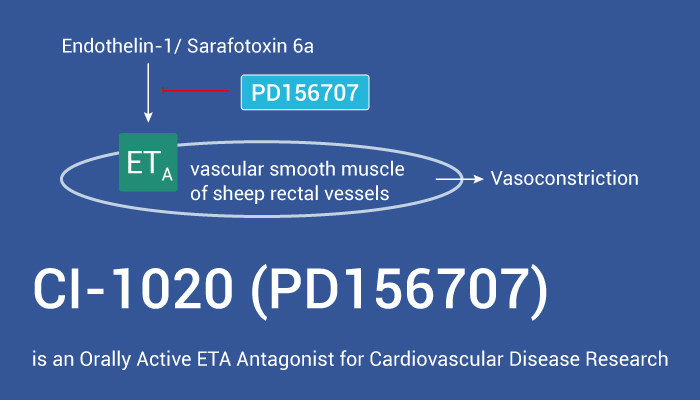Chronic hypoxia leads to pulmonary hypertension and pulmonary vascular remodelling in many mammalian species. Hypoxic pulmonary vasoconstriction (HPV) is thought to play a key role in the development of pulmonary hypertension with endothelin-1 (ET-1) as a possible mediator. However, the mechanism of HPV remains unclear.
The study found that ET-1 levels in lung and plasma have also been shown to rise in rats exposed to chronic hypoxia,’ in plasma of humans at high altitude, and in humans with pulmonary hypertension. Meanwhile, ET-1 binds to and activates receptors (ETA, ET) in the lung. In addition, ET-1 potently constricts human saphenous vein and is co-mitogenic for vascular smooth muscle cells. In a word, ET-1 is a potent vasoconstrictor of the pulmonary circulation, and to stimulate the proliferation of vascular smooth muscle cells.
Today, we will introduce an ET,-selective antagonists — CI-1020 (PD156707), which is currently being evaluated in clinical trials for a number of cardiovascular diseases.

CI-1020 is an orally active and selective ETA antagonist for cardiovascular disease research.
CI-1020 (PD156707) is an orally active and selective antagonist targeting endothelin (ETA) with an IC50 value of 0.3 nM.
Firstly, CI-1020 blocks intimal hyperplasia in human saphenous veins completely in organ culture. Secondly, CI 1020 inhibits hypoxic pulmonary hypertension and blocks ET-1-induced pressor responses following oral administration. Thirdly, CI-1020 (1 μM, 28 days) blocks intimal hyperplasia in human saphenous veins completely in organ culture.Meanwhile, CI-1020 (1 μM, 14 days) is not toxic to the tissue. Furthermore, CI-1020 (30 mg/kg, p.o.) represents full inhibition of the ET-A and has no significant effect on basal blood pressure in normotensive rats. Finallly, CI-1020 (40 mg/kg, p.o.) attenuates established pulmonary hypertension in rats previously exposed to chronic hypoxia.
In sum up, CI-1020 is an orally active and selective antagonist targeting ETA for cardiovascular disease research.
Reference:
[1] Doherty AM, et al. Pharm Biotechnol. 1998;11:81-112.
[2] Sheedy W, et al. Pulm Pharmacol Ther. 1998 Apr-Jun;11(2-3):173-6.
[3] Lohsiriwat V, et al. Pharmacol Res. 2011 Jun;63(6):490-5.